PricewaterhouseCoopers estimated that by 2030, automation of processes and digitalization may reduce transportation costs by 47%. At the moment, fleet business is facing a range of challenges, including increased prices, declined productivity of drivers, late delivery, and growing customer demand. The industry expects to overcome a part of these issues by implementing the latest technologies and fleet management app development.
According to a MarketsandMarkets report, the market of fleet management software is going to reach $28.66 billion in 2022 compared to $12.08 billion in 2016. This means that if you are planning to develop trucking fleet management software, the time is right. In this article, we will discuss the benefits of such applications, the problems they aim to solve, and what steps to take to create a fleet management app.
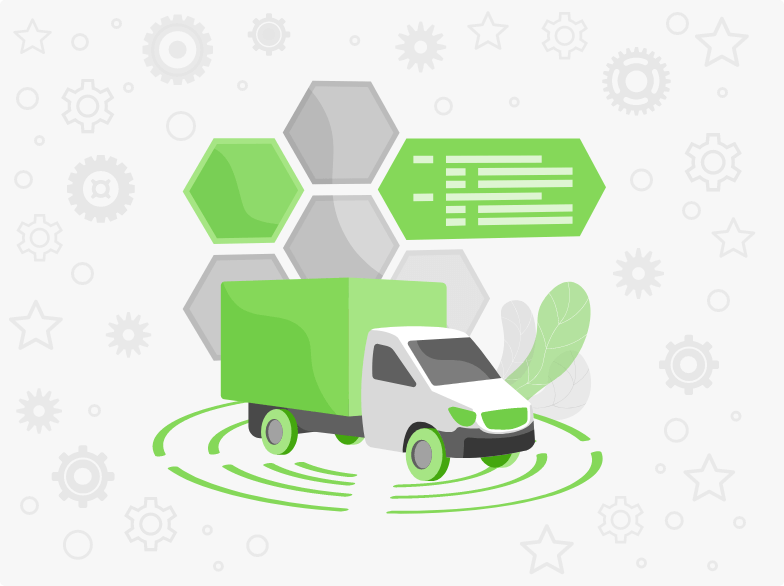
What is Fleet Management Application
A fleet management mobile app is software that helps enterprises manage, organize, and coordinate their vehicles remotely. The main goal of such a system is to provide smooth performance of the fleet while reducing operational costs and ensuring the satisfaction of drivers and customers. Fleet management software, or simply FMS, helps businesses to gather, store, track, and utilize information related to the fleet, logistics, and team members.
Challenges that Fleet Business Owners Face
There are many challenges that fleet owners face on a regular basis. These issues impact performance, productivity, and consequently profits. Here are the main issues that fleet business owners may face day after day which can be solved with the help of a fleet management application:
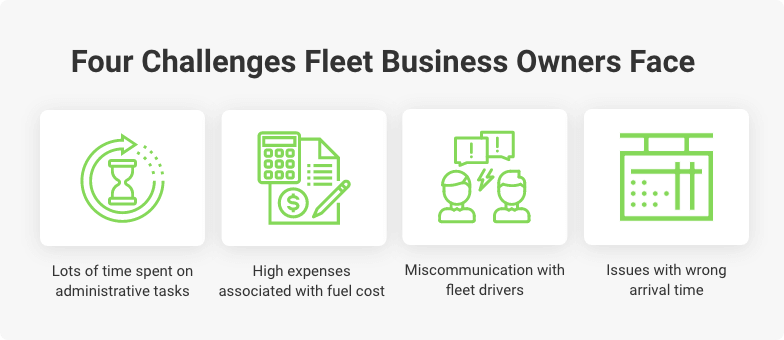
1. Too much time spent on administrative tasks
According to Entrepreneur, 49% of fleet managers claim that their workers spend up to 2 hours on invoicing and quoting, 42% on choosing the best performer of the task, 40% on keeping clients informed, and 43% on managing expenses. This means that hours and hours of work are lost on activities not related to transportation.
2. High fuel cost
According to the same Entrepreneur survey, 34% of fleet managers believe that truck fuel costs are higher than necessary. And fuel expenditures make up one of the biggest shares of the total money spent. Building a fleet management app allows for monitoring fuel consumption, checking if it is overused, and evaluating if a driver’s behavior impacts expenditures.
3. Miscommunication with fleet drivers
It may be challenging to communicate with drivers, especially when they are on the road. Reaching them via email, SMS, or phone may not be possible, which significantly challenges the communication process. Fleet managers say that communicating the schedule and requirements to workers takes too much time and impacts productivity.
4. Wrong arrival time
Based on Entrepreneurs’ findings, over 60% of fleet managers say that they fail to meet the schedule, which has a negative effect on the company. Incorrectly estimated arrival time leads to user dissatisfaction and harms the company’s reputation. Customers want to know the exact day and time when their orders will be delivered.
Benefits of Fleet Management Software
Before fleet management systems were introduced, such problems as fuel tracking and delivery schedules were completed on paper. Fleet management software has significantly improved performance, helped to reduce costs, and returned control over the enterprise to their owners. Below we will discuss the main reasons why creating a vehicle tracking application is a good idea.
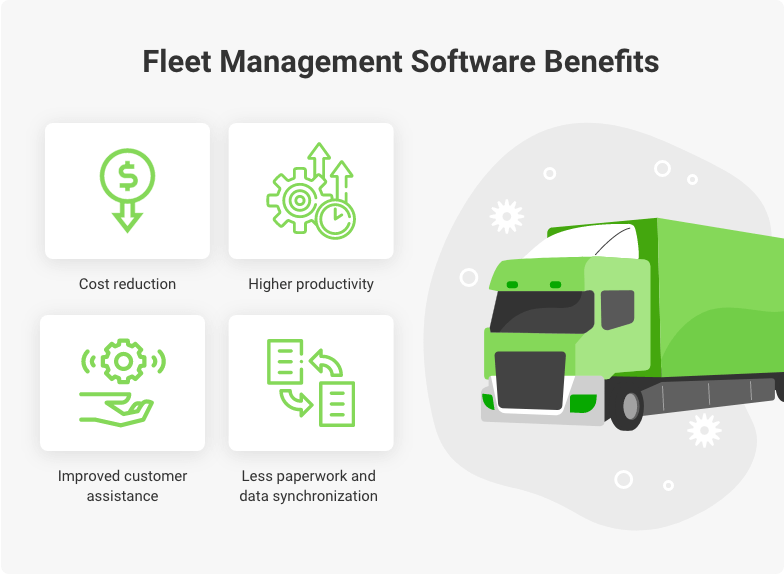
Cost reduction
Software created specifically for fleet management may significantly reduce maintenance costs. Drivers, administrators, and other team members will spend less time on their duties. For example, GPS technologies help to plan the route and get updates on traffic. This information may also be used to plan the time of departure and arrival, track repair history, and optimize working schedules. Such software not only saves time but also money.
Improved customer assistance
When using fleet management software, business owners and managers know where the vehicle is located at any given period of time. Thus, they may provide customers with accurate data on delivery progress and choose the vehicle which is the closest to the client’s location.
Higher productivity
After the data about the fleet is collected, managers can analyze which vehicles are working efficiently and have the lowest maintenance costs. Top-notch vehicle management apps have machine learning algorithms that are able to collect and process data and then make predictions for the fleet. This helps to service the vehicle on time and avoid accidents. Such data can also be helpful in the long-run to decide which vehicles should be kept in the business.
Less paperwork and data synchronization
Modern fleet management systems combine functions of Customer Relationship Management and accounting software. Such integration allows company departments to work with a single app without sending the same data through multiple channels. For example, to drivers, human resources specialists, and finance departments.
Due to digitalization, personnel are involved in problem-solving and analysis instead of paperwork and completing routine tasks. This way, the company is able to save time and funds and to use the workforce more efficiently.
Features Required for a Car Fleet Management App
Transportation management systems are used for vehicle tracking and evaluating a wide range of components from fleet conditions to customer satisfaction. If you want to develop an app for a trucking company, here are the features it should include.
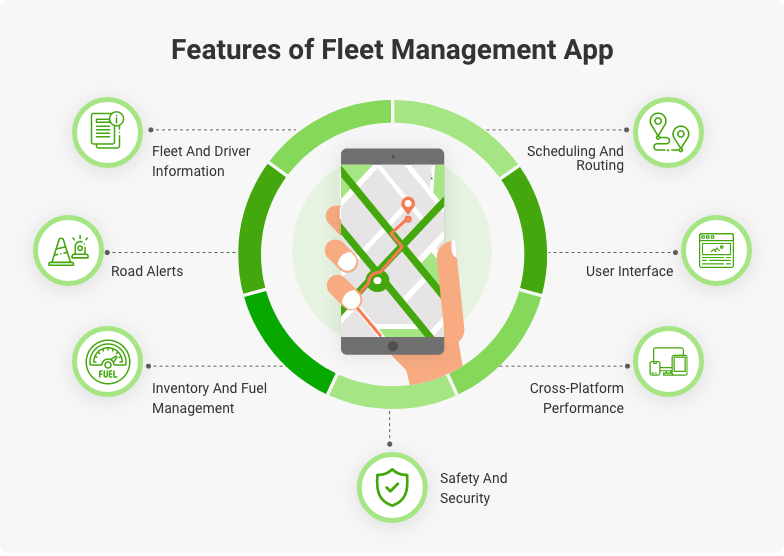
Fleet and driver information
It is much simpler to manage the fleet if you have information on vehicle conditions and specifications, repair history, and miles. Due to GPS technologies, it is possible to collect real-time data on vehicle location, traveled miles, and road maps.
With fleet management system functionality, managers can monitor drivers’ files and records, performance statistics, and licenses and certifications. Such information may help to choose the best driver for a particular shipment or vehicle.
To keep drivers engaged and motivated, it is possible to add a competitive angle to the job and provide a KPI report and rewards program.
Thus, drivers won’t have to calculate their mileage and vehicle fuel consumption, because the app will do the estimation automatically. In addition, they will be rewarded for success.
Scheduling and routing
With the help of FMS, it is possible to plan and monitor the cargo efficiently, as well as to conduct any tasks related to schedules and routes. This technology allows you to determine the best routes by considering the traffic situation, destination, and the number of gas stations along the way. This information helps not only to reduce costs and deliver the cargo on time but also to ensure proper performance of the fleet.
Inventory, inspection, and fuel management
Fleet management apps are able to reduce downtime and count operating cycles by recording and tracking any information related to vehicles, cargo, and other business systems. FMS also ensures compliance with the rules and requirements of inspections and governmental laws.
In addition, this software can monitor fuel consumption and expenditures to identify vehicles and drivers with low fuel efficiency.
Safety and security
All fleet management software should contain safety tools that protect the driver and the vehicle. These tools include theft alerts, remote control, and emergency assistance. Monitoring the time of departure and arrival, as well as the speed and other performance indicators helps fleet owners to protect themselves against false accusations. If the vehicle is stolen, FMS allows you to track missing assets or reduce the speed of a particular vehicle.
Don’t forget about ensuring encryption and software protection. Data provided by the company or user is confidential, as the task of your app is to provide for its safety.
Road alerts
Sending notifications about the weather and road conditions and alerts about changes helps to keep drivers informed and safe. Collecting and monitoring data in real-time allows you to notify drivers and other team members about possible dangers including accidents.
Cross-platform performance and user interface
To ensure the convenience of use and bigger coverage, your application should run equally well on iPhone, iPad, and on Android devices. In addition, the app should be simple to use, have a clear interface, and include customization features.
How to Create a Fleet Management Application
To create a fleet tracking app it is necessary to plan the process in advance and to choose a team of specialists for proper execution. Here are the steps to create fleet management software.
Onboard a team of specialists. Usually it should include project/product managers, business analysts, iOS and Android developers, backend developers, UI/UX designers, marketers, and testers.
Create a specification. This is a detailed plan of the features you want the future app to include. For example, design peculiarities, customization features, and GPS monitoring. The team builds the app based on the specifications.
The design stage. Any good design should be simple, clear, and convenient. Thus, UI/UX specialists should make the app intuitive and user-friendly. A good idea is to get familiar with competitors’ apps to see what users like or dislike about them.
Back-end development. At this stage, developers work on every feature indicated in the specifications.
Testing. The QA team should test the application and detect possible mistakes. This stage can be conducted either by testing specialists or by uploading the product on testing websites and getting comments and feedback.
Create a marketing plan. Along with the back-end and front-end development, market specialists should evaluate how to attract businesses to the app and make them want to stay. It is also important to choose a monetization strategy (i.e. how you will earn money from the app).
To ensure smooth performance and clear communication of the team, it’s also necessary to hire a project manager. This is a specialist responsible for planning, scheduling and monitoring the progress of the project. Whenever a problem or question occurs, the customer should contact the PM who will then communicate with the department in charge.
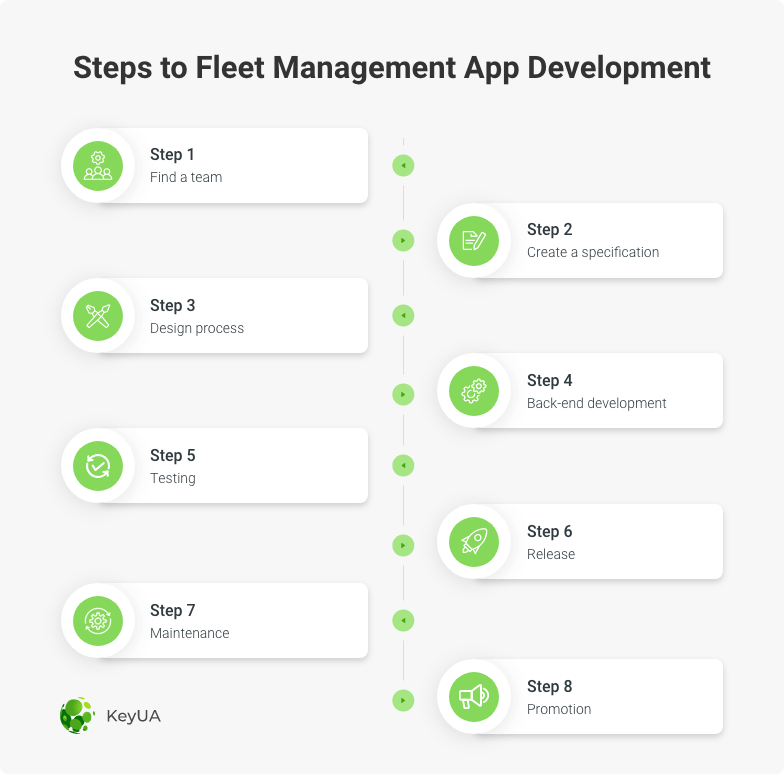
Fleet Management Application Development [Step-by-Step]
Hire our experienced KeyUA team to create a powerful fleet management application. Get in touch now to get an estimate for your project.
Contact usThe Cost to Develop Fleet Monitoring Software
The cost of such an app greatly depends on your needs and expectations. The greater the number of features and the more complex they are, the more it will cost. For example, backend development involves such stages as management of cloud infrastructure, user authentication, API integration, security, and GPS.
UI design is also important. Designers work on mobile navigation, icons, and the convenience of the app. Don’t forget that many fleet companies have lots of vehicles and may need to spend hours inside the app. Thus, designers should additionally work on color schemes and fonts that will be appealing. Each of these stages takes time and increases the final price of your fleet management app.
One way to reduce costs is to launch a Minimum Viable Product. This is a basic version of your future app which possesses the minimum necessary functions. After launching and testing it and collecting comments and feedback, it is possible to decide what functions and tools should be added.
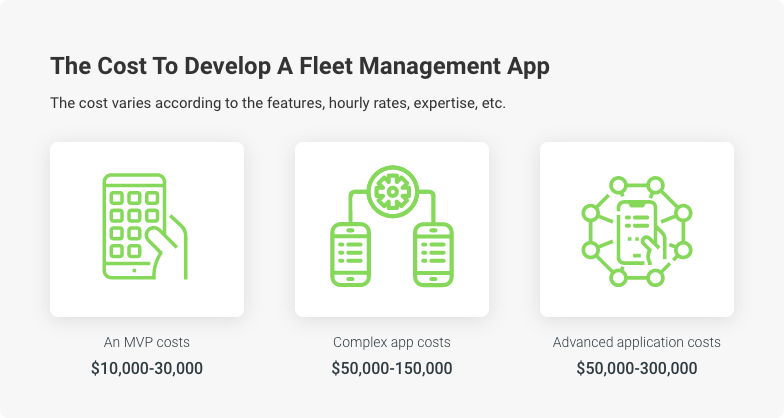
On-Demand Fleet Monitoring App Development Cost
FAQ
1. Custom vs generic fleet management smart solutions: which one to choose?
Unlike generic FMS, custom software is tailored to the needs and specific goals of the client. Software that is made to solve a particular problem is always more effective than a pre-built application.
2. What are the advantages of fleet management?
Fleet management aims to solve multiple issues including control over maintenance and fuel costs, improved safety and satisfaction of drivers and customers, real-time tracking, and greater fleet longevity.
3. What is GPS tracking?
A fleet management platform based on a GPS system provides users with information about the vehicles in real-time. It includes engine performance, vehicle speed, distance, and drive behavior. With this information, it’s much easier to create viable strategies.
4. How to improve fleet management?
One of the most effective ways of improving fleet management is bybuilding an application that allows for digitizing documents, tracking vehicles and fuel, and increasing satisfaction of drivers and customers.
Conclusion
Fleet management companies face multiple challenges on a daily basis. In order to remain competitive and improve the quality of the provided services, they need to implement new technologies and digitalize their systems. GPS and transportation technologies offer broader opportunities for creating effective routes, optimizing costs, and improving users’ satisfaction.
If you want to create top-notch fleet management software that will be tailored to the needs and peculiarities of your company, the best decision is to hire professional developers and market specialists. They will analyze your competitors, create a specification, and assign experts with the necessary skills and background.
KeyUA provides turnkey solutions for creating a product that will fully meet your requirements. Get a customized fleet management solution from professionals.
Get in touch







 Unit 1505 124 City Road, London, United Kingdom, EC1V 2NX
Unit 1505 124 City Road, London, United Kingdom, EC1V 2NX

Comments
Leave a comment